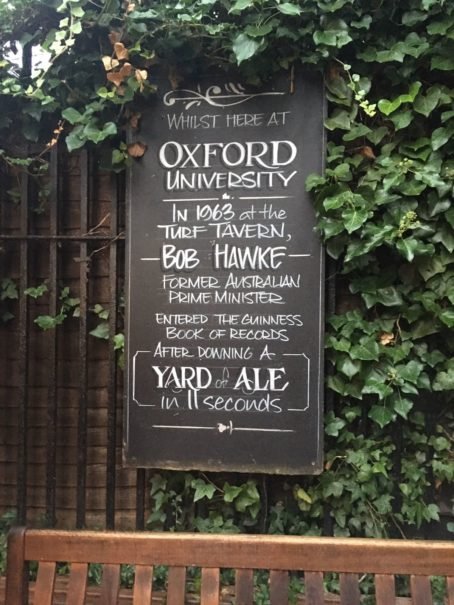
The Familiar Shame of Ordering a Foster’s in a Real Ale Pub

The Familiar Shame of Ordering a Foster’s in a Real Ale Pub
Ale in Oxford
The heart of scholarship in the Anglophone world, Oxford is host to the oldest and probably most renowned English-speaking university. For a thousand years, philosophers, scientists, literary types, and politicians have spent their formative years here, learning and researching and crafting ideas that have helped define the progress of the human species.
Inevitably, that involves drinking. And along with a millennium of scholarship comes a millennium of misbehavior. At the Turf Tavern—a hideaway watering hole that dates back to the 14th century—a blackboard hung up on the ancient stonework in the beer garden celebrates the spot where Bill Clinton did not inhale. Another commemorates the 1963 achievement of a Rhodes Scholar named Robert Hawke, who set a world record for downing a yard-glass of ale in 11 seconds. Impressive enough in itself, Bob would later cap this with the secondary feat of becoming prime minister of Australia.
In other ways the Turf is commonplace enough; a fairly typical English pub given its age and pedigree. The menu is unsurprising; sausage rolls and Scotch eggs and burgers and pulled-pork nachos. And on the day I visit, the clientele is representative of Oxford in the late summer: plenty of German families, American backpackers, Chinese retirees, English road-trippers, and a smattering of town-and-gown (locals and academics).
But if the nature of a pub is home away from home, that’s doubly true for an English pub. Whether it’s your local down the road, a Wetherspoons on the Orkney Islands, or an ancient tavern in Oxford, a good pub is familiar. On tap at the Turf you’ll find a drink common across the country—real ale.
Real ale, or cask ale, as it used to be known, differs in a couple of important ways from the beer that most of us drink today. Primarily, it’s brewed in the cask in which it’s served. That means it continues to ferment even while it’s sitting in the pub. Secondly, it’s made using traditional ingredients and without added carbonation. For someone used to a beer that crackles like cola, real ale feels very flat on the tongue and sits heavily on the stomach.
Often, and particularly near to the end of the cask, a muddy sediment will rest at the bottom of the glass; a result of the absence of filtering and pasteurization that most beers go through.
At one stage in the 1970s, cask ale was so rare that a group of enthusiasts banded together to form a consumer campaign for its preservation. The successful relabeling of cask ale by the “Campaign for Real Ale” (CAMRA), alongside a more recent hipster-led interest in craft brewing, has led to a more than 250 percent growth in the number of cask ale breweries in the last 10 years.
I take my pint—a Cornish amber ale called Doom Bar—out the back; settle in, and take a sip. It’s turbid. It tastes familiar, but with more flavors, and also more muted, like a drink from a rainwater tank. If I’d grown up with it, I decide, real ale would certainly be my drop. But too accustomed now to the acrid flatus of a mass-produced lager, my next drink’s a shameful Foster’s.